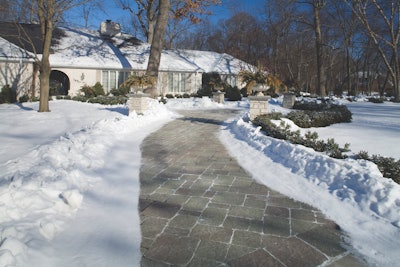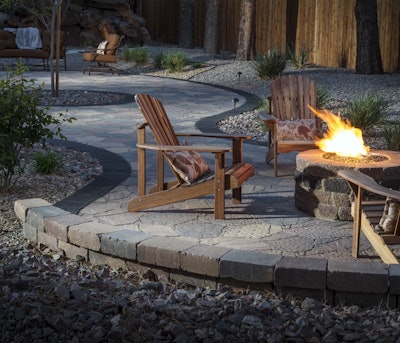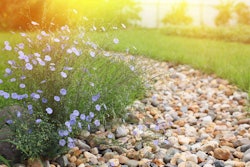 Photo: Belgard
Photo: BelgardBeing in the midst of winter, it’s no surprise that many parts of the country are still experiencing the occurrence of snow.
With this kind of weather happening and predicted to happen more often than not over the next couple of months, experts at Belgard have determined there are a few steps you can take to help preserve the longevity of your customers’ pavers this season.
When it comes to helping your customers manage and utilize the spaces you’ve created for them year-round, Joe Raboine, national design and training specialist on the Belgard Design Studio team, has a few ideas you can implement to keep things running more smoothly.
Utilizing high-quality pavers
When it comes to choosing what kind of pavers to use on a customer’s landscape, Raboine suggests planning ahead by using higher quality pavers. In the long run, it could end up saving you a lot of time and your customers a lot of money, because there’s a smaller chance that the pavers will need to be repaired or replaced due to winter damages.
“It’s really important that the concrete itself is a higher psi, because the weaker the concrete, the more likely that salt and deicing agents will affect it,” Raboine says. “It’s really the strength of the concrete itself, the psi strength, and it’s also the absorption and the porosity. If they are more porous, water can get in there and can create issues.”
Raboine says that if the paver used is a weaker mixed product, it’s more likely that salt and ice will affect it. This, he says, can commonly be seen in concrete if it is not cured properly or enough cement is not used in the mixture.
If the mixture does not set and cure correctly, it can ultimately lead to salt, water and ice cracking the mixture and causing more issues.
Moisture-resistant, water-shedding materials
When it comes to customers having outdoor sheds and decks, Raboine suggests choosing woods that can easily shed water, or consider talking to your customer about a composite decking material that is moisture-resistant to help cut down on the slipperiness of the surface. One product Belgard suggests for this job is MoistureShield.
 Photo: Belgard
Photo: Belgard“Wood has similar issues, but people don’t think about it all the time,” Raboine says. “The reason they recommend that you keep your deck or your house painted or stained is that if a crack forms, water gets in there and ice will do, pretty much, the same type of thing. It’ll freeze and expand and make those cracks bigger. So, it’s important that if you do have a deck to make sure it’s continually maintained and sealed. Even if it’s treated, it’ll be the same issue over time.”
Over the last 10 years, Raboine says composite decking has made a big introduction on the market. And he notes that there are certain types of composite decking that have built-in features that can help prevent water from penetrating the material. He adds that these certain types of composite are also, essentially, maintenance free.
Driveway design
If you service an area that frequently sees snow and ice in the winter, it’s probably a good idea to go ahead and keep that in mind when designing a customer’s driveway.
If your customers live in an area that sees snowplows often in the winter, design the driveway to accommodate snow plows, trucks and more to keep your customers from an upsetting experience down the road.
“There are some pavers that are a little bit more aggressive, where the texture is really aggressive,” Raboine says. “If you’re in an area that you know is going to be plowed a lot and they’re not going to use a snow blower, we would suggest they keep that in mind about how that’s treated. It is a concrete product and is very strong, but if you hit it with a plow continually, you’re going to get some chipping or scratching.”
Raboine notes that the color runs throughout the entire paver, so any chipping that occurs will not affect the longevity of the paver; he notes that the previously mentioned precautions are strictly to enhance the esthetic of the paver.
He recommends for those who know their customers are in areas with an increased amount of snowplow activity to search out pavers that aren’t so aggressive in texture, or for homeowners that are insistent about having that particular paver, he suggests making provisions to help keep plows away from the area.
Raboine says that many people also forget that a darker color of paver will attract more sunlight and heat, thereby helping snow and ice melt faster.
“It’s something to consider, especially if you’re on a relatively steep driveway,” he says. “You want to make sure you’re doing whatever you can to keep the ice and snow from forming on there.”
Rock salt and other alternatives
“A lot of deicing agents are pretty harmful, actually, to concrete,” he says. “So, it’s actually better to use rock salt. But in any of those instances, especially with rock salt, you just want to make sure you’re not broadcasting it past (the driveway). Or if the driveway’s pitched to certain areas where you consistently get that, you’re going to get a concentration of salt that will kill that grass and the plants eventually, if you’re not careful.”
 Photo: Belgard
Photo: BelgardRaboine recommends using rock salt and other deicing agents cautiously in any instance. He also says another, and possibly better, alternative to rock salt would be to clean the driveway and follow that up with sand. Since sand is more environmentally friendly and typically runs on the cheaper side of the spectrum, Raboine says this is one of his top suggestions.
“It works just as well because it gives you some traction,” he says. “And the sun will heat up the sand and help the ice melt faster.”
Raboine also notes that a final and equally important step in the paving process is to seal the paver, especially for those who live in areas that will have frequent harsh weather.
“That’s going to give you another level of protection that’s going to prevent water from absorbing into the brick itself,” he says. “It’s the same with the salt and everything. It’ll just stay more on the surface. So, I would definitely recommend that they seal it every three to five years, depending on the sealer. It’s not necessary; it’s just a precaution and one more step you can take.”











